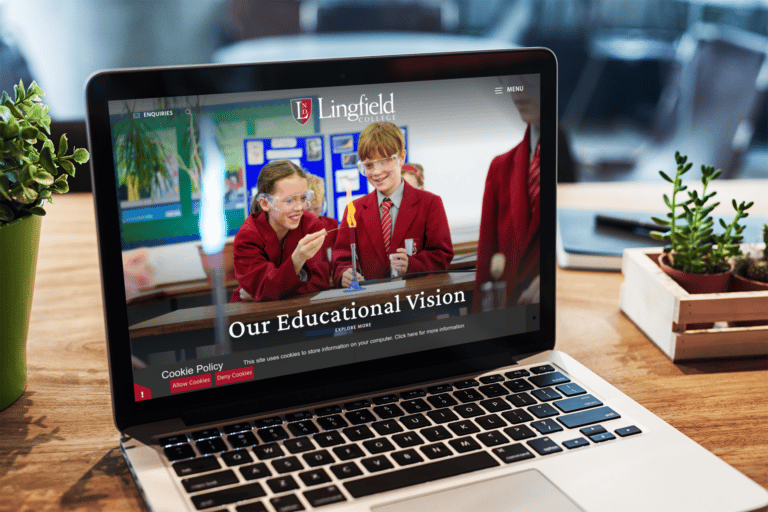
A sensible, well-planned approach to social media can be a real asset for schools looking to find cost effective ways to engage with parents and the local community. This guide aims to highlight eight of the common social media mistakes we see to help you get the most out of the social world.
Low-quality profile pictures
As it accompanies every post you make and is often used across different platforms, your profile picture is a key aspect of your social media identity. Avoid using a low-quality image that is stretched (changed to fit an aspect ratio that doesn’t match the original picture) blurry (usually this happens when your image is a low resolution) or pixelated in order to make an excellent first impression.
Commonly, schools will use their logo as a profile picture. This is a good choice as they tend to be bold, colourful and unique to the school, so your content will stand out in social feeds. Each social media platform will either specify the recommended size for profile pictures when you are uploading a new one, or have this information in the help or support area. This isn’t the same across different social platforms, so we suggest that you consult this for each social media profile you update.
Spelling and grammar mistakes

It may seem a little basic, but it’s important to get this right. An occasional mistake here and there isn’t going to derail anyone’s social media strategy, but making repeated mistakes can quickly create a negative impression.
Not only will frequent errors discourage people from following and engaging with your social media, but it can also affect your offline reputation. Thankfully, this is easy to avoid with a little patience and an effective editing process. It’s always harder to spot mistakes in your own work, so it’s a good idea to get a colleague to take a look before posting. Having a simple review process in place that applies across the school can help to eliminate mistakes.
Not reflecting the school’s identity
Every school has its own vision, values and personality that form a unique identity that is reflected in every aspect of school life, from classroom set-up, to uniforms, behavioural policies, communications to parents and much more. Social media is a great opportunity to communicate your values, so updates should always be consistent in their tone of voice.
Failing to do this can create a social media account that feels overly corporate, disjointed and out of touch with the ‘offline’ presence of the school. Anyone who knows the school well may avoid engaging with the account as a result, and it may also fail to communicate the school’s core identity to potential new staff and parents effectively.
Treating every social media platform the same

When most people think of social media, several platforms come to mind including Facebook, Twitter, Instagram and LinkedIn. Every one of these platforms is different and requires a unique approach; there is no ‘one size fits all’ solution to digital communication. Publishing the same type of content on each platform can prevent you from unlocking the potential of each.
LinkedIn, for example, is a business-focused tool that is especially relevant for staff recruitment, networking, and the professional development of existing colleagues, while Instagram is focused on capturing a moment in time visually, making it a great way to share snapshots of life around the school. Think of it as a way of highlighting the best moments of the school day. Twitter, on the other hand, works around fast-paced, short-form public conversations, and as such will require more monitoring and interaction in order to be useful. This may be particularly useful for communicating with other schools and commenting on public issues such as education policy, and therefore we would advise considering carefully who is best placed to control this tool. Facebook, meanwhile, focuses more on a close-knit, more personal network of followers. It’s also possible to create private areas within Facebook, so this can be ideal for coordinating with groups of parents.
Setting up an online presence, then leaving
Social media is not something that can be switched on and left to run by itself. Regular updates and interaction are essential to build and maintain a healthy level of engagement. If someone starts following a school on Facebook or Twitter, only to find that those feeds only post one update a month, they are likely to stop paying attention and find more engaging ways to communicate with the school community.
In the busy life of a school, it can be understandably difficult to maintain a consistent social presence. One way to effectively manage this is with a social media calendar to plan out what needs to be updated and when. In addition to this many free tools such as HootSuite allow for multiple platforms to be managed in one place and for posts to be scheduled ahead of time.
Trying to do too much

Given that every single platform needs a strategy of its own and that none can be set up and left to their own devices, there is an inevitable time investment involved in getting social media right. It is essential, therefore, to ensure that your school doesn’t try to take on too much; it will always be better to excel with one network than to struggle to maintain multiple platforms.
Consider what your school wants to get out of social media and which platforms will be most relevant to that goal. You can also investigate the numerous social media management tools that are available (such as Hootsuite and Buffer). These allow you to schedule updates to go out over a period of time, and can also give you statistical information about which updates are being perceived positively by your followers. Our advice is to develop one channel at a time; you should only consider extending your online presence to a second network when there is a positive initial presence in place that is meeting your goals.
Spamming followers
While you should aim to maintain a regular level of communication with your followers, it is equally important not to overdo it. People following your social media accounts are likely to also be following many others and may feel bombarded if they receive multiple updates per day from the school, especially if only some of these are relevant to them. Getting the balance right can be tricky at first, so you may want to ask for feedback from your followers after a trail period.
In addition, it is also important to consider the subject of your updates carefully. If you have a school event to promote, for example, it’s tempting to post regular messages advertising this, especially in the week leading up to it. While this will increase exposure, daily updates are also likely to annoy followers who will see the same information repeatedly, so try to keep your messages varied. If you do want to communicate around one thing multiple times, try to find a new angle for each post you make. For example, if you are promoting a school performance, why not post comments from the students involved about their experience? This is likely to be more impactful than repeated posts giving practical information about location, timings and where to buy tickets.
Forgetting the ‘social’ part of social media

Social media is not designed to be a platform for solely promoting your own messages and agenda. Instead, these platforms are designed around two-way communication. Any school investing time in social media will be expected to participate in conversations, so if people comment on updates or send direct messages try to respond accordingly. Responding to people’s comments and questions also gives a school’s social media profile a personal touch and this can be an excellent tool for increasing engagement.
One common concern schools hold around social media is the dreaded negative comment. No one likes to receive an unsupportive response, but they do happen from time to time and can actually present an opportunity if handled correctly. The aim is to be direct, polite and honest, taking a similar approach as you would when responding to a complaint in person. Engaging with the person’s concerns can not only turn a frustrated parent into a happy one but also show others that the school’s ethos is to be helpful, responsive and dedicated to providing good communication.
For more information on using social, read our article on making your social media more engaging









